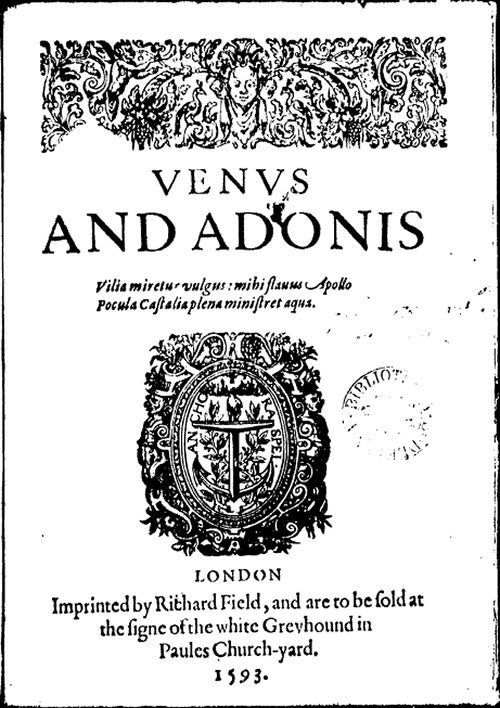For any writer, the first publication is always the most exciting. However, in the case of the most famous writer of all, it was also the most forgettable. Such an irony presents itself in the form of William Shakespeare’s 1593 narrative poem, “Venus and Adonis,” his first work to officially appear in print.
Richard Field (1561–1624), a London publisher and cultural connoisseur, brought “Venus and Adonis” out as a quarto pamphlet, perhaps hoping that the promising young scribbler’s work would establish an everlasting positive reputation for his business. But the poem wasn’t exactly the complete breakthrough success for which both author and printer were hoping. Financially, it did fairly well, and by 1640, the poem had been reprinted fifteen times. Yet it wasn’t the work that really launched Shakespeare’s career as a dramatist. This would be the three-part play series Henry VI, with the first part being performed, though not yet published, to public acclaim at the Rose Theatre in 1592. Modern-day readers aren’t particularly impressed by “Venus and Adonis,” either. No one ever names it when asked what their favorite Shakespearean play or poem is.

There are several factors that scholars attribute to the general lack of interest in Shakespeare’s first appearance in the world of publication. First, the source material didn’t come from his own imagination, but rather he borrowed from ancient Latin poet Ovid’s Metamorphoses. Romeo and Juliet, Shakespeare’s much more memorable and iconic tragic love story, may have closely mirrored Ovid’s Pyramus and Thisbe, but it at least included original elements such as fourteenth-century Italian politics and some bawdy domestic humor that very much appealed to his Elizabethan audience. “Venus and Adonis” is technically closer to a work of fanfiction rather than a work of art that Shakespeare could entirely call his own.
Second, “Venus and Adonis” features what would today be identified as an asexual protagonist, or perhaps a closeted homosexual protagonist, a concept which didn’t exactly enchant Shakespeare’s original readers, who wanted staunchly heterosexual romantic figures to fantasize about and identify with. In this poem, Venus is the goddess of love. Adonis is the god of don’t-touch-me-I’m-busy. As literature scholar Lauren Shohet describes,
Adonis’s desire differs from Venus’s both in its target and in the way it relates subject to object. Whereas Venus desires an eros that merges lover and beloved, Adonis desires the hunt, which depends upon boundaries between subject and object (albeit contingent and perhaps temporary ones).
This plotline didn’t universally appeal. Elizabethans, especially the wealthy nobility with the greatest influence, liked poems where true love triumphs. “Venus and Adonis” just didn’t deliver.
Weekly Newsletter
Third, Shakespeare was still finding his footing as a stylistic poet, and “Venus and Adonis” lacked basic structure and coherence. It was blatantly amateurish and exposed Shakespeare’s youthful over-enthusiasm for playing with literary devices and concepts before he fully understood them. Shakespeare scholar Donald G. Watson comments bluntly, noting that
many modern interpretations have proven dead ends rather than ways out of the labyrinth of the poem’s difficulties; indeed, once beyond the glittering surfaces of the poem, like Wilbur, we are likely to feel lost in a maze of motifs, ironies, ambivalences and inclined to yield to the temptation to take any promising avenue of analysis.
Luckily, Shakespeare wasn’t discouraged by or apologetic about his early attempts to make art. If he’d given up and put down his pen, we wouldn’t have Romeo and Juliet, Macbeth, Hamlet, or Othello. It’s a valuable lesson to any writer. Keep trying, and don’t copy the work of others too closely.







